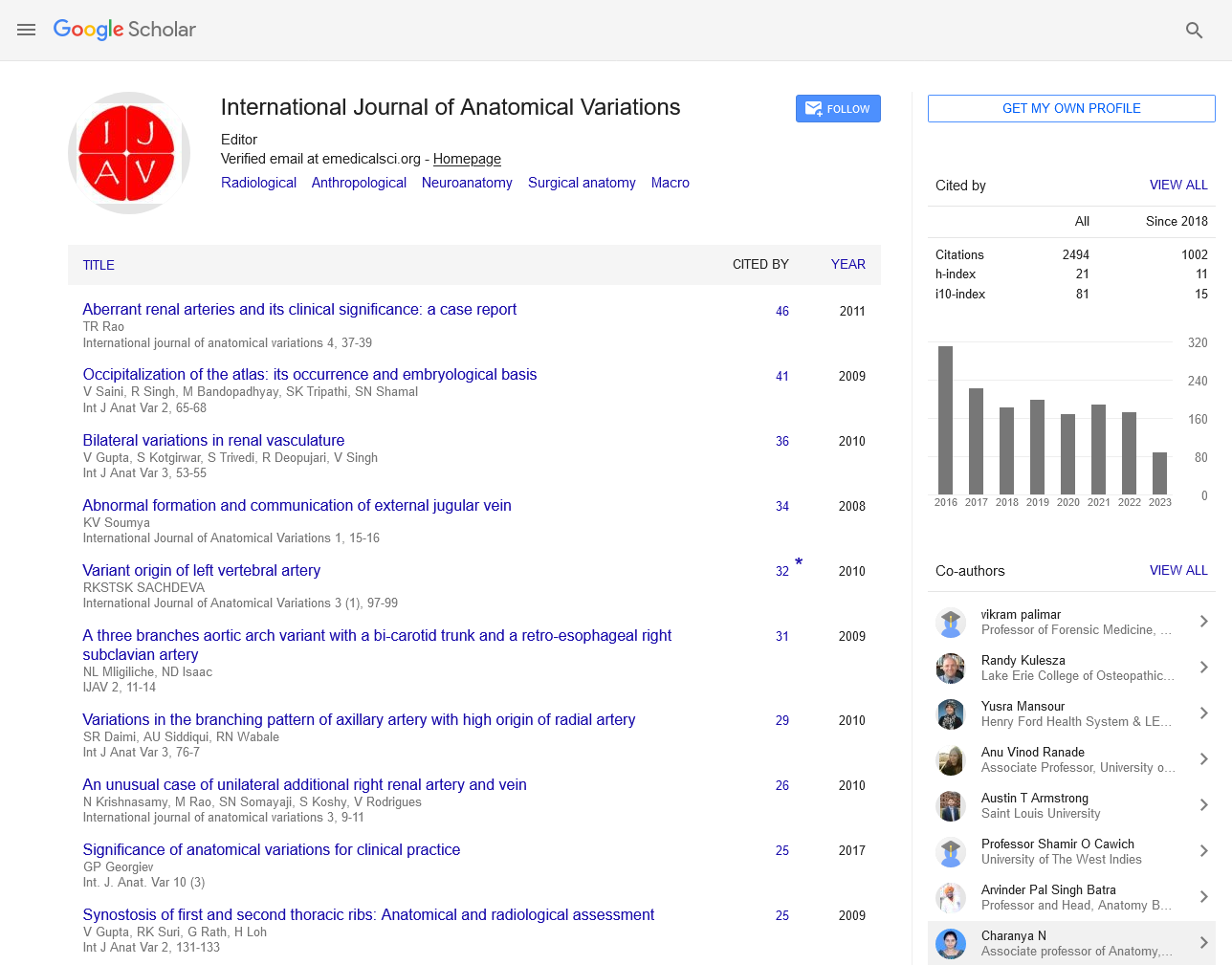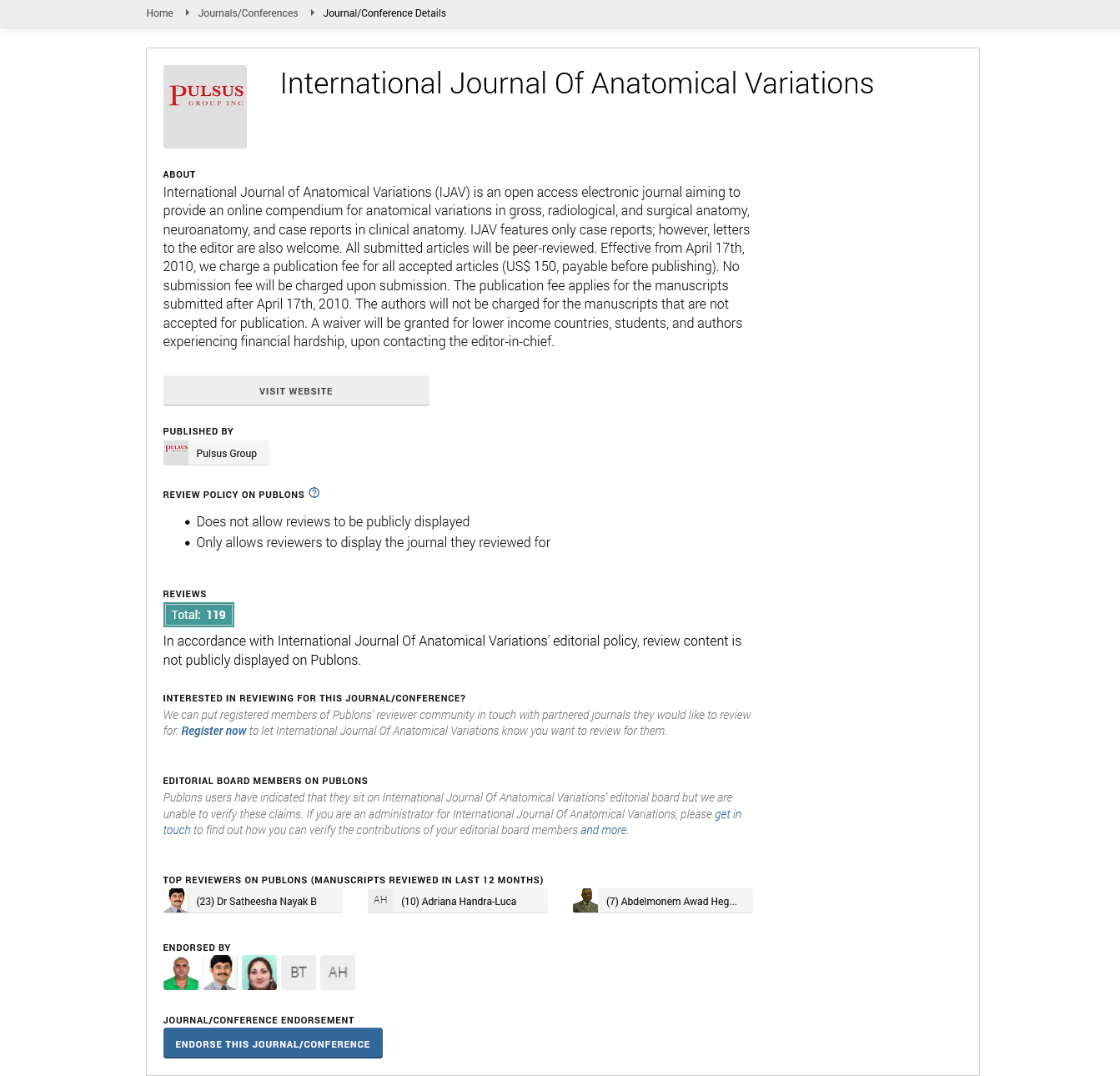Sectional Anatomy a Comprehensive Review of its Importance Techniques and Applications in Modern Medical Imaging
Received: 01-Mar-2025, Manuscript No. ijav-25-7641; Editor assigned: 04-Mar-2025, Pre QC No. ijav-25-7641 (PQ); Reviewed: 19-Mar-2025 QC No. ijav-25-7641; Revised: 26-Mar-2025, Manuscript No. ijav-25-7641 (R); Published: 30-Mar-2025, DOI: 10.37532/1308 4038.18(3).499
Citation: Bosco J. Sectional Anatomy a Comprehensive Review of its Importance Techniques and Applications in Modern Medical Imaging. Int J Anat Var. 2025; 18(3): 767-768.
This open-access article is distributed under the terms of the Creative Commons Attribution Non-Commercial License (CC BY-NC) (http://creativecommons.org/licenses/by-nc/4.0/), which permits reuse, distribution and reproduction of the article, provided that the original work is properly cited and the reuse is restricted to noncommercial purposes. For commercial reuse, contact reprints@pulsus.com
Abstract
Sectional anatomy refers to the study of the human body through crosssectional images. This discipline has become increasingly vital due to the rise of advanced imaging modalities such as computed tomography (CT), magnetic resonance imaging (MRI), and ultrasound. By examining the body in planar slices, sectional anatomy provides clinicians, radiologists, and surgeons with detailed spatial awareness critical for diagnosis, treatment planning, and medical education. This article explores the foundations, imaging techniques, educational value, clinical applications, and future directions of sectional anatomy.
INTRODUCTION
The field of sectional anatomy has evolved in parallel with the advancement of medical imaging technologies. Unlike traditional gross anatomy [1], which relies on dissection and surface visualization, sectional anatomy offers a planar understanding of the internal structures of the human body. With the advent of high-resolution imaging, clinicians now rely heavily on sectional views to navigate the complex internal landscape of organs, vessels, muscles, and bones. This article aims to provide a comprehensive overview of the key elements that define sectional anatomy and its indispensable role in contemporary healthcare [2].
HISTORICAL CONTEXT
Sectional anatomy has roots in ancient anatomical illustrations and cadaveric studies, but it became a cornerstone of modern medicine with the development of imaging technologies in the 20th century. The introduction of CT in the 1970s and MRI in the 1980s revolutionized anatomical visualization, allowing real-time, non-invasive internal imaging [3]. These innovations required a paradigm shift from traditional anatomical learning to understanding the body in slices or sections.
ANATOMICAL PLANES AND TERMINOLOGY
Understanding these planes is essential for interpreting imaging modalities and for effective communication among healthcare professionals.
Imaging Modalities in Sectional Anatomy
CT uses X-rays to create detailed axial images. It is especially valuable for bone imaging, trauma evaluation, and detecting internal bleeding. With multiplanar reconstruction (MPR), CT can render coronal and sagittal views from axial slices [4].
MAGNETIC RESONANCE IMAGING (MRI)
MRI excels in soft tissue contrast, making it ideal for brain, spinal cord, joint, and abdominal imaging. Unlike CT, MRI does not use ionizing radiation. T1- and T2-weighted images offer different tissue characterizations, enhancing diagnostic accuracy.
ULTRASOUND
Ultrasound provides real-time imaging with no radiation. It is commonly used in obstetrics, cardiology, and musculoskeletal imaging. High-resolution probes allow detailed sectional visualization of superficial and deep structures.
POSITRON EMISSION TOMOGRAPHY (PET) AND HYBRID IMAGING
PET, often combined with CT or MRI, adds metabolic function to anatomical images. This combination allows for precise localization of pathological activity [5].
EDUCATIONAL SIGNIFICANCE
Sectional anatomy is now a central part of medical curricula. Digital atlases, 3D reconstruction tools, and virtual dissection platforms have transformed anatomical education. These resources bridge the gap between textbook knowledge and clinical practice, allowing students to navigate real patient imaging confidently.
CLINICAL APPLICATIONS
Surgeons rely on sectional imaging for navigation during procedures. Detailed cross-sectional views ensure precision in tumor resections, vascular repairs, and organ transplantation. Sectional imaging is critical for tumor localization, staging, and treatment monitoring. CT and MRI provide high-resolution images that help differentiate between malignant and benign masses. MRI-based sectional anatomy is foundational in evaluating brain lesions, vascular abnormalities, and guiding stereotactic surgery. CT angiography and cardiac MRI provide precise sectional views of the heart and vessels, essential for diagnosing coronary artery disease, congenital anomalies, and valvular disorders.
TECHNOLOGICAL ADVANCEMENTS AND 3D RECONSTRUCTION
Modern imaging systems can reconstruct 3D models from multiple 2D sections. These models enhance visualization, surgical simulation, and even 3D printing for prosthetics and anatomical teaching. Artificial intelligence (AI) is also emerging in automating sectional image interpretation and segmentation.
CHALLENGES AND LIMITATIONS
Complex Interpretation: Accurate interpretation requires in-depth anatomical knowledge and training. Radiation Exposure: Particularly with CT, repeated imaging may pose risks. Cost and Accessibility: Advanced imaging tools may be expensive or limited in low-resource settings.
FUTURE PERSPECTIVES
The future of sectional anatomy lies in integrating AI, virtual reality (VR), and augmented reality (AR) into imaging workflows. These technologies will enhance diagnostic precision, training efficiency, and patient-specific treatment planning. Portable imaging devices and telemedicine may also democratize access to high-quality sectional imaging worldwide.
CONCLUSION
Sectional anatomy is an essential discipline bridging anatomy and clinical practice through modern imaging. It enriches diagnostic capability, surgical accuracy, and medical education. As imaging technologies continue to evolve, sectional anatomy will remain central to delivering effective, precise, and personalized healthcare.
REFERENCES
- Shigeru H. Glomerular Neovascularization in Nondiabetic Renal Allograft Is Associated with Calcineurin Inhibitor Toxicity. Nephron. 2020; 144 Suppl 1:37-42.
- Konschake M, Olewnik Ł. Unknown variant of the accessory subscapularis muscle?. Anat Sci Int. 97(1), 138-142.
- Youdas JW. Bilateral presence of a variant subscapularis muscle. Int J Anat Var. 2017; 10(4):79-80.
- Janda P, Pękala J, Malinowski K. The subscapularis muscle‐a meta‐analysis of its variations, prevalence, and anatomy. Clin Anat. 2023; 36(3):527-541.
- Jacob SM. Bilateral presence of axillary arch muscle passing through the posterior cord of the brachial plexus. Int. J. Morphol., 27(4):1047-1050, 2009.
Indexed at,, Google Scholar, Crossref
Indexed at, Google Scholar, Crossref
Indexed at, Google Scholar, Crossref






